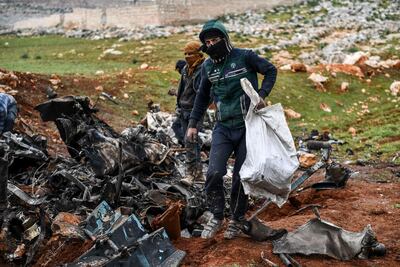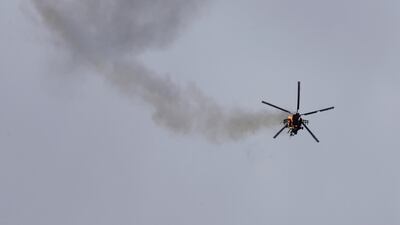It took more than a minute for the helicopter to go down, a trail of smoke and fire billowing behind it before the helicopter hurtled into a remote field in Syria’s north-western countryside.
The incident on February 11 would be the first of two anti-aircraft man-portable air defence system, or Manpads, strikes fired by rebels that have downed two Syrian Air Force helicopters since the start of the month.
Another, on February 14, downed an aircraft over western Aleppo province. Both attacks killed all crew members.
There is still little information about where the coveted weapons may have come from.
Supporters of the Damascus-led war effort blame Turkey, which is caught in an attempt to halt major Syrian army advances that have displaced about 900,000 civilians since December 1.
Reportedly launched by rebels from the Turkish-backed National Liberation Front, it now appears the Manpads strikes might have been fired by Turkish soldiers embedded with rebels in north-western Syria.
Foreign Policy Research Institute fellow Elizabeth Tsurkov said the strikes indicated that Turkey was “willing to escalate and risk downing Russian jets to be able to operate inside Idlib”.
“However, the launches have been inconsistent and Russia and the regime are able to continue bombing Idlib, indicating that Ankara is getting cold feet," Ms Tsurkov said.
"Turkey appears to be dithering and unsure about how to escalate further without exposing to greater risk the thousands of troops it brought into Idlib.”

And yet, while the rare strikes have prompted debate about the future of the pro-government offensive eating away at territory on Syria’s last opposition stronghold, they have also brought to the fore one of the nine-year conflict’s longest-standing controversies.
The Syrian opposition’s search for a retort to the regime bombardments that have attacked communities across the country since 2011 almost serves as a history of the opposition itself.
High hopes in the start gave way to internal divisions. Promises of support from fair-weather allies would later be sold out in foreign capitals.
‘Grave of the jets’
Opposition activists were already calling for a no-fly zone to protect protesters in October 2011, before Syrian President Bashar Al Assad turned to his arsenal of fighter jets and helicopter gunships to attack communities rebelling against Damascus.
That would soon change. Human rights groups started documenting the widespread use of aerial strikes from July 2012 onwards.
The Syrian Air Force conducted indiscriminate air strikes that “did not or could not distinguish between civilians and combatants", a 2013 report by Human Rights Watch said.
That kind of practice, flagrantly illegal under international law, continued and expanded as the war went on.
Civilian infrastructure including residential areas, bakeries and hospitals, have become a routine target of Assad’s bombing campaign.
“Since the beginning of the revolution, the main thing in favour of the regime was its aircraft, and the fact the opposition didn’t have anti-aircraft weapons,” says "Abu Abdullah", a doctor originally from Eastern Ghouta who now lives abroad.
Once a major rebel stronghold on the very outskirts of Damascus, Ghouta was besieged by pro-government forces in 2013.
Syrian aircraft routinely targeted homes, hospitals and public spaces in Ghouta.
Abu Abdullah says he survived several bombardments targeting the hospital where he worked.
And yet this month’s strikes are not the first time that rebels have responded with Manpads.
One former Syrian army officer who defected to the opposition in 2012 said rebels started seizing anti-aircraft weapons from government stores that year.
In one of the most significant cases, they stormed a Syrian Special Forces base in the Aleppo countryside in November 2012, taking vast caches of anti-aircraft missile systems, some dating back to the 1973 October War with Israel.
Crates of weapons were forced open, with their contents distributed among smiling rebel fighters.
“These missiles changed the game,” claims the defector, who says he was co-ordinating with rebels responsible for the raid at the time.
Combined with more standard weapons like vehicle-born heavy machineguns, the rebels began to hit back at Mr Al Assad’s air force.
“There was one month in 2013 - the rebels used to call it the ‘grave of the jets’,” the defector remembers.
‘Late, as usual’
But the weapons were often old and badly maintained, no match for the Syrian Air Force’s more modern fighter jets, let alone the allied jets that would intervene in Syria to devastating effect in September 2015.
Pro-government forces also changed tactics, flying higher to avoid the risk of being shot down by the rebels’ Manpads. The bombing continued.
But the doctor said that after Russia intervened, the aircraft and weapons were more advanced.
Abu Abdullah said that if the rebels had anti-aircraft weaponry, the regime and its allies would never have been able to enter Ghouta.
For that to happen, the opposition needed more support from outside. But its backers erred to the side of caution by not sending anti-aircraft missiles capable of shifting the balance of the conflict.
They feared that the rebels, or the growing number of militant groups fighting in Syria after 2013, would use them to shoot down civilian aircraft.
Politics also played its part. Manpads can fundamentally change a war.
That was seen in Afghanistan in the 1980s, when US-supplied anti-aircraft missiles allowed rebels and militants to devastate the Soviet air force and ultimately force Russia’s retreat in early 1989.
As such, the likely Manpads transfers by Turkey demonstrate a willingness to genuinely hold off advances by pro-government forces, or to try and send a warning message.
Even so, many observers believe it may already be too little, too late.
“The shooting down of those helicopters appears to have momentarily succeeded at deterring Syrian helicopter flights and barrel bombing attacks over Idlib,” says Tobias Schneider, a Global Public Policy Institute research fellow.
“While this should be considered a success on humanitarian grounds alone, it is inconsequential for the future of Idlib, which will be decided between Turkey and Russia.
“Thus far, Turkish deployments have not affected the activities of Russian air force, and unless Turkey proves willing and able to escalate to the point where it affects Russia’s strategic calculus, it will not succeed at holding the line in Idlib.”
The defector calls this month’s Manpads strikes a “message from Turkey that they are serious about protecting these areas”, but one that may have already come too late.
“If this had happened earlier, in 2015, it would have brought Russia back to negotiations,” he said.
“But now, it’s a delayed message. Late, as usual.”

